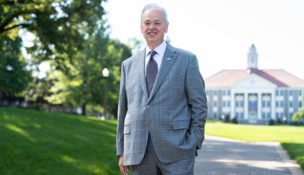U.Va.’s board of visitors will hold a special meeting on Nov. 11 to discuss strategic fund
U.Va.’s board of visitors will hold a special meeting on Nov. 11 to discuss strategic fund
The University of Virginia board of visitors has called a special meeting on Nov. 11 to talk about its $2.3 billion Strategic Investment Fund, and a big part of the focus will be on the affordability of a college education.
William H. Goodwin Jr., the board’s rector, assured the House Appropriations Committee during an appearance Monday that the board is taking legislators’ concerns and criticism to heart about recent tuition increases and the impact they are having on the middle class, which typically does not get as much help with student financial aid. His remarks came during a regular meeting of the committee.
While U. Va. has gotten high marks for helping students from families with incomes of $80,000 and less, “My own opinion, when I look at the data, is we don’t do as well as I’d like with the $80,000 to the $160,000 group. We need to think about what we could do to support that,” Goodwin said.
U.Va’s board approved a 3 percent tuition increase in February for the 2016-17 year that was later revised downward to 1.5 percent after the state kicked in more funding than expected. The 1.5 percent raise followed a raise of $1,000 for each of two years for in-state students that had been approved in 2015. Raising tuition at a time when the school’s pooling of resources were being put into a Strategic Investment Fund prompted a former rector, Helen Dragas, to criticize the board, saying the funds should have been used to help keep tuition rates low.
“Many of you have talked to me about a rollback of tuition,” Goodwin told the board. “… Not that it can’t be done, but it’s complicated,” he said.
Without a rollback, over the next three to four years, Goodwin said U.Va. would have close to a zero tuition increase, or close to 1 to 2 percent.
With the most recent raise in tuition, incoming in-state students will pay about $13,000 this year in tuition, which represents about 40 percent of the annual costs for an education, noted Goodwin. After throwing in other fees, housing, books, etc., the cost is closer to $30,000 per year for in-state students and higher for out-of-state students who pay about $45,000 in tuition and fees.
Delegate Kirk Cox, (R-Colonial Heights) the House Majority Leader and a member of the House Appropriations committee, told Goodwin, “I hope you all will look at an actual rollback of $1,000 each year. That sends a substantial message on tuition affordability for middle-class kids.” Kirk said he was concerned that families earning between $80,000 to $150,000 a year “seem to be the ones that are extremely stressed.”
Goodwin also told the Appropriations Committee that the board has met with the university’s admissions office “and we’re going to try and change 100 more slots to in-state that are currently going out-of-state … 100 may not sound like a lot, but that’s a fair amount for us from a revenue standpoint,” he said.
However, he urged legislators not to mandate by law that public higher education institutions in Virginia limit the number of out-of-state students. Some people have been talking about a 75 percent threshold for instate students, he added, with U. Va.’s current threshold at about 67 percent.
“I know some of you want to pass a bill … Please. I ask you not to do that. It’s a real source of income for us … We’d much rather try to work on the number of in-state students, by having more students in total or by switching some of them from out-of-state to in-state. “
In another bid to keep college affordable, U.Va. and other schools in Virginia are accepting more transfer students from community colleges. According to Pat Hogan, U.Va.’s chief operating officer who also spoke before the Appropriations Committee, the university offered admission to 651 transfer students last year, with 560 of them coming from community colleges.
Hogan said that U.Va. plans to produce an annual report for the public much like an audited financial statement that would give a details on how monies from the investment fund had been spent, including earnings on the fund and all disbursements.
In closing out discussion on Goodwin’s report, Del. Chris Jones, (R-Suffolk), the committee’s chairman, told Goodwin, “The middle class has been squeezed and it’s getting squeezed harder. That $80,000 to 150,000 a year has to be a target. The cost of higher education has gotten to be a larger percentage [of income] in many cases than for people buying a home … As the dialog continues, I hope you will look at the questions raised today as you move forward and with your special meeting next month.”
Virginia’s legislative members raised questions earlier about the use of U.Va’s strategic fund during a special hearing in August of the Senate Finance Education and House Appropriations Higher Education Subcommittee.
In September, U.Va's board approved funding for the first round of projects from the fund, which Goodwin says was created as an opportunity to improve academic quality, help minimize tuition costs and student debts, conduct research and offer world-class medical care. The first round of about $26 million in funding included 13 research projects and academic programs, with the projects vetted by committees made up of faculty members and administrators.
Regarding how the fund might to used to help defray tuition increases, Goodwin said, “I’m not going to tell you that we have the answer now, but we’ve identified it as something we want to think about and wrestle with.”
e
















